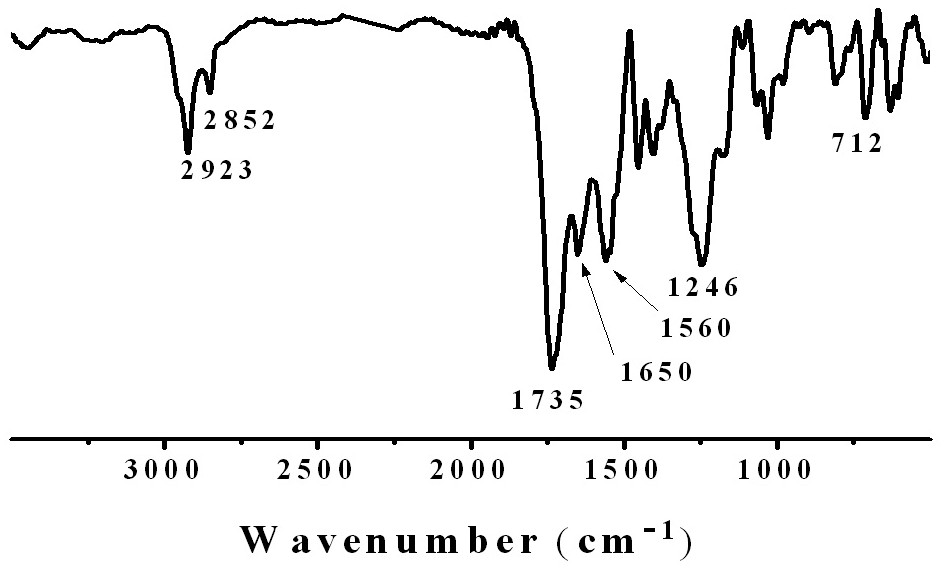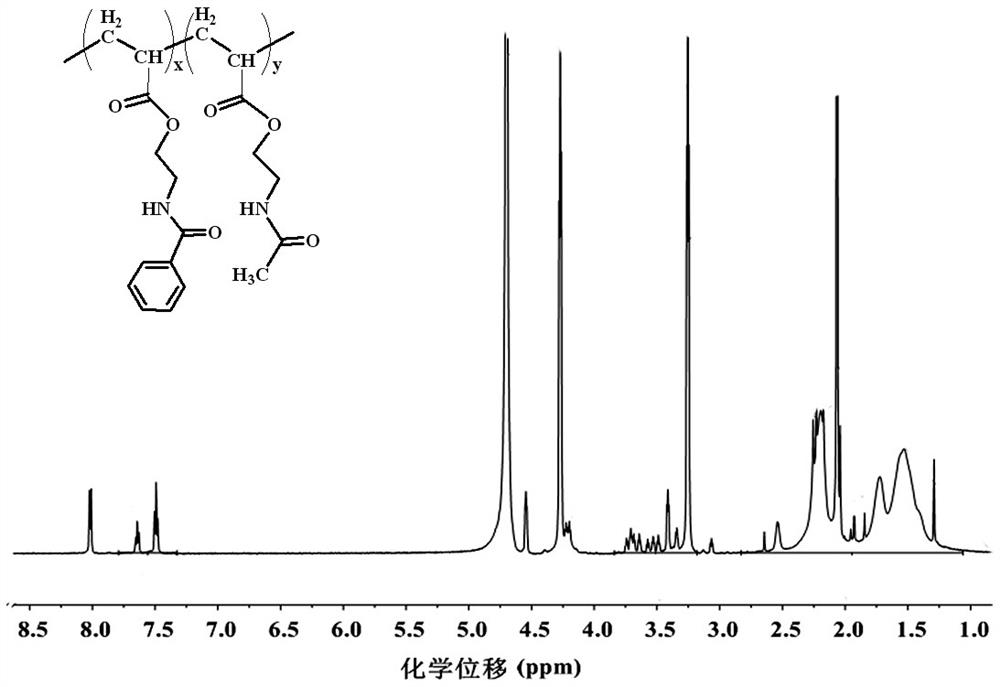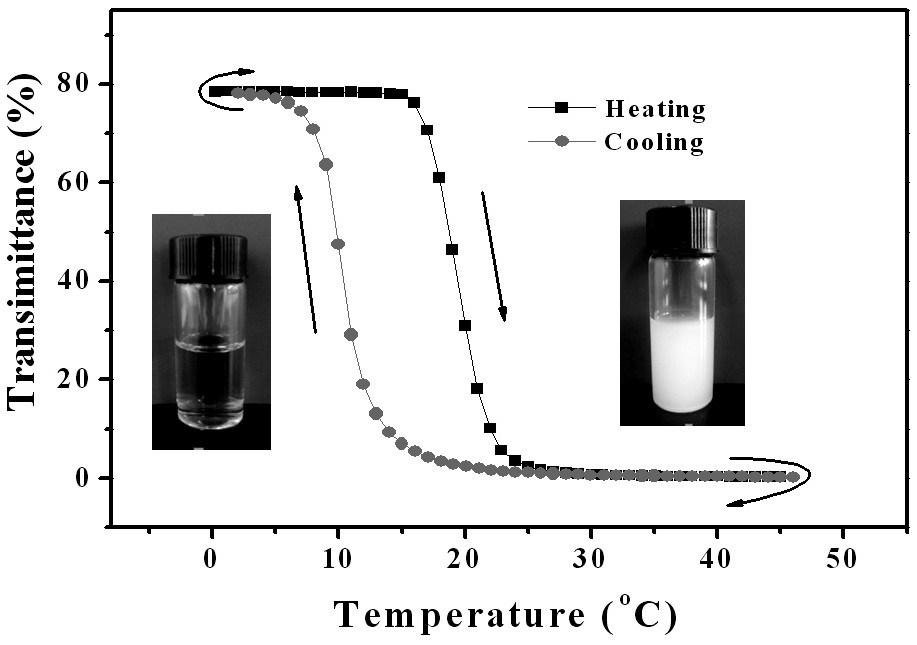A temperature-sensitive poly(acetamidoethylacrylate-co-benzamidoethylacrylate) and its preparation method
A technology of benzamido ethyl acrylate and acetamido ethyl acrylate is applied in the field of polymers and their preparation, and achieves the effects of simple preparation method, good temperature-sensitive properties, and excellent temperature-sensitive properties
- Summary
- Abstract
- Description
- Claims
- Application Information
AI Technical Summary
Problems solved by technology
Method used
Image
Examples
Embodiment 1
[0038] (a) Typical small molecule ring-opening reaction
[0039] In a 25 mL flask equipped with a magnet, add accurately weighed 0.720 g of acrylic acid monomer and 6 mL of absolute ethanol, and stir for 5 min to make the acrylic acid and ethanol mix evenly. Accurately weigh 0.6375 g of 2-methyl-2-oxazoline and 0.3675 g of 2-phenyl-2-oxazoline, add them into the flask, and stir at room temperature for 6 h to ensure that the ring-opening reaction is complete. Thin-layer chromatography (TLC) was used to observe whether the ring-opening reaction of oxazoline and acrylic acid monomer was complete or not with anhydrous ether as developing solvent.
[0040] (b) Free radical copolymerization reaction
[0041] After the reaction of the acrylic acid monomer is complete, accurately weigh 0.025 g of azobisisobutyronitrile (AIBN) and add it to the reaction flask, pump out the air in the flask and fill it with dry high-purity nitrogen, repeat 5 times to eliminate the oxygen in the air , ...
Embodiment 2
[0046] (a) Typical small molecule ring-opening reaction
[0047] In a 25 mL flask equipped with a magnet, add accurately weighed 0.720 g of acrylic acid monomer and 6 mL of absolute ethanol, and stir for 5 min to make the acrylic acid and ethanol mix evenly. Accurately weigh 0.680 g of 2-methyl-2-oxazoline and 0.294 g of 2-phenyl-2-oxazoline, add them into the flask, and stir at room temperature for 10 h to ensure that the ring-opening reaction is complete. Thin-layer chromatography (TLC) was used to observe whether the ring-opening reaction of oxazoline and acrylic acid monomer was complete or not with anhydrous ether as developing solvent.
[0048] (b) Free radical copolymerization reaction
[0049] After the reaction of the acrylic acid monomer is complete, accurately weigh 0.030 g of azobisisobutyronitrile (AIBN) and add it to the reaction flask, pump out the air in the flask and fill it with dry high-purity nitrogen, repeat 5 times to eliminate the oxygen in the air , t...
Embodiment 3
[0051] (a) Typical small molecule ring-opening reaction
[0052] In a 25 mL flask equipped with a magnet, add accurately weighed 0.720 g of acrylic acid monomer and 6 mL of anhydrous methanol, and stir for 5 min to make the acrylic acid and ethanol mix evenly. Accurately weigh 0.723 g of 2-methyl-2-oxazoline and 0.221 g of 2-phenyl-2-oxazoline, add them into the flask, and stir at room temperature for 8 h to ensure that the ring-opening reaction is complete. Thin-layer chromatography (TLC) was used to observe whether the ring-opening reaction of oxazoline and acrylic acid monomer was complete or not with anhydrous ether as developing solvent.
[0053] (b) Free radical copolymerization reaction
[0054] After the reaction of the acrylic acid monomer is complete, accurately weigh 0.0250 g of azobisisoheptanonitrile and add it to the reaction flask, extract the air in the flask and fill it with dry high-purity nitrogen, repeat 5 times to eliminate the oxygen in the air and preve...
PUM
| Property | Measurement | Unit |
|---|---|---|
| molecular weight distribution | aaaaa | aaaaa |
| molecular weight distribution | aaaaa | aaaaa |
| molecular weight distribution | aaaaa | aaaaa |
Abstract
Description
Claims
Application Information
 Login to View More
Login to View More - R&D
- Intellectual Property
- Life Sciences
- Materials
- Tech Scout
- Unparalleled Data Quality
- Higher Quality Content
- 60% Fewer Hallucinations
Browse by: Latest US Patents, China's latest patents, Technical Efficacy Thesaurus, Application Domain, Technology Topic, Popular Technical Reports.
© 2025 PatSnap. All rights reserved.Legal|Privacy policy|Modern Slavery Act Transparency Statement|Sitemap|About US| Contact US: help@patsnap.com



